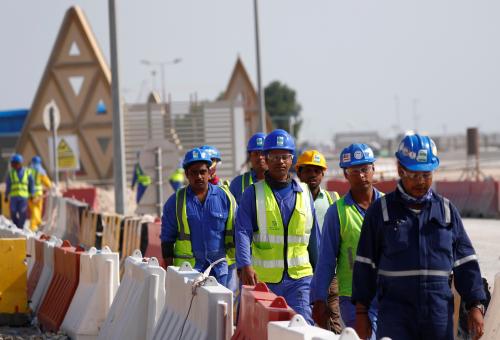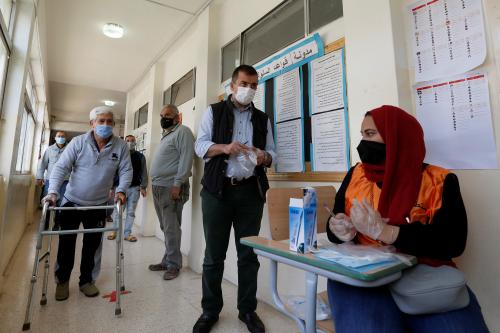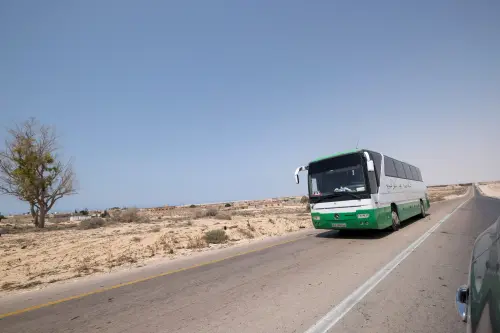Content from the Brookings Doha Center is now archived. In September 2021, after 14 years of impactful partnership, Brookings and the Brookings Doha Center announced that they were ending their affiliation. The Brookings Doha Center is now the Middle East Council on Global Affairs, a separate public policy institution based in Qatar.
With the fabric of Syrian society badly damaged after three years of conflict, the first step is to pull the country back together at the community level – leading to a national dialogue that takes into consideration the needs of groups from Kurds to Christians to tribes.
Salman Shaikh, the director of the Brookings Doha Center, has been involved in creating the Syria Track II Dialogue initiative, whose goal is to target a core group of influential Syrians and design processes through which Syrian communities and constituencies can build relationships.
“We are bringing in a wide variety of voices from Syrian backgrounds, and involving them in the design,” he says. Here, Shaikh discusses what can be done to pull Syria back together again, starting at the local level; the “peace assets” available on the ground; and the major hurdles to building such relationships in divided communities.
Syria Deeply: What can be done to pull Syria back together at the community level? What are the “peace assets” on the ground?
Salman Shaikh: You have to focus on the social makeup of the societies and look to see how you can build a network of bridges that will change the situation at the local level. So far the center of that has been the Assad regime. It has, in the past, effectively built networks across tribes, the business and economic elite, the bourgeoisie and various [minority] communities. That encapsulates the Syrian mosaic, and it’s been held together by a combination of [regime-induced] support, financial largesse – and intimidation, fear and even force.
Now that [mosaic] seems to have come undone to some degree, even though we cant deny the government still enjoys a wide amount of support – especially with the emergence of extremists. But that support has also eroded over the course of this conflict. The rest of the country is being divided into smaller pieces. That’s the challenge we face – we’re looking at a highly-fragmented country, and that has affected all these communities.
Syria Deeply: What kind of local reconciliation can exist, in this climate? What are the biggest roadblocks you see? Warlords? Subnational identities?
Shaikh: People divide [the current landscape] between those in government-controlled areas and those in opposition areas, but if you’re going to put Syria back together, you have to see if you can [connect the two].
What we’ve seen with local ceasefires is that there is no trust and confidence being built between local government and opposition entities. Instead what we’ve seen are these tactical, short term measures imposed by the government and accepted by rebel-held communities because they have no other choice. The truces don’t apply across the board – like to liberated areas. We have to go back to working on how we can improve these [relationships].
You have local councils, you have activist groups, but you need an international framework that brings them together. You have to put communities in a national context. You need a political process that brings everyone forward – tribal leaders, Alawites, Kurds, Christians, the business elite – and puts them on a national stage. You need a process that’s legitimized at the international level, not just at the domestic level. It can’t just be the Assad government running this.
Syria Deeply: What “peace assets” are there on the ground? How would the local representatives to a national dialogue be selected?
Shaikh: When you design a national dialogue process, you have a measure of selection at the local level – maybe [it starts with] the local councils or some other body. You can’t have a process of self selection because the situation on the ground is much too fragmented. I believe that there are local constituencies that can forge ahead and work together at the local level – tribal and Kurdish elements working together, activists and local councils, and certain older elites like the business community. But in my view, that’s not going to translate to a more sustainable peace locally.
There needs to be a national process that’s legit by an international actor working alongside Syrians themselves. Syria is in pieces. So you can come to localized arrangements which can help bring about temporary truces and some greater access and safety for humanitarian relief – which can help in the establishment of a field hospital or a bakery – but they are still susceptible to the broader national fight and even the regional elements that drive this conflict.
This interview was originally published in Syria Deeply.
The Brookings Institution is committed to quality, independence, and impact.
We are supported by a diverse array of funders. In line with our values and policies, each Brookings publication represents the sole views of its author(s).



Commentary
What Can Be Done to Stitch Syria’s Communities Back Together?
August 28, 2014